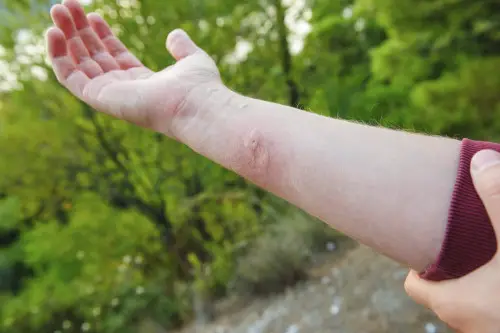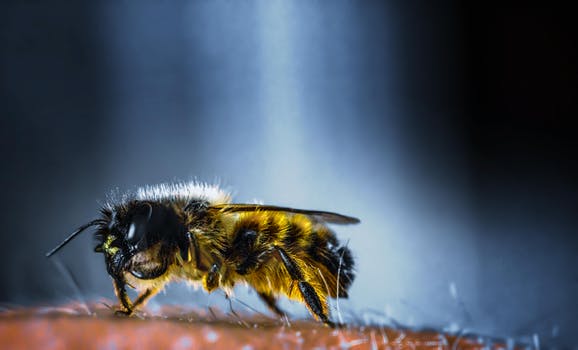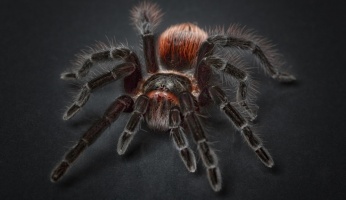Bee Sting Treatments to Try at Home
 Bee Sting Treatments to Try at Home
thegearhunt.com
Bee Sting Treatments to Try at Home
thegearhunt.com
Bee stings are an outdoor nuisance that is quite common. Most of the time, they are simply annoying and treatment at home is all that will be necessary when it comes to easing their pain. However, if you have an allergy to them or if you are stung quite a few times simultaneously, you might have a reaction that is more serious and if that happens, you will need emergency treatment.
There are several things that you can do to avoid being stung by a bee, hornet or wasp. You can also learn in the following paragraphs how to treat them if you do happen to get stung.
Symptoms
Bee stings can produce a few different reactions that can range from temporary discomfort and pain to severe allergic reactions. If you are stung once, the reaction that you have might not be the same as it will be the next time you are stung. The next time a bee stings you, it might be better or worse.
Mild Reactions
Most of the time, a bee sting can be a minor thing. Some of those mild reactions might be:
- Slight swelling in the area where you were stung
- A red welt right where you were stung
- Sharp, instant, burning pain at the site of the sting
With most people, the pain and swelling disappear within just a few hours.
Moderate Reaction
Sometimes, people who are stung by a bee or some other type of stinging insect will have a reaction that is a bit stronger. Symptoms and signs might include:
- Swelling at the sting site that will gradually enlarge over the next 48 hours
- Extreme redness
These moderate reactions typically resolve themselves within a period of 5 – 10 days. If you have a moderate reaction, that doesn’t necessarily mean that the next time you happen to be stung you will have a severe allergic reaction. In fact, some people will have similar moderate reactions every single time they are stung by a bee. If you have a moderate reaction such as this, you might want to discuss prevention and treatment with your doctor, especially if your reaction becomes stronger with each sting.
Severe Allergic Reaction
Anaphylaxis (severe allergic reaction) to bee stings can be potentially life threatening and will require immediate emergency treatment. However, only a small percentage of people who get stung by a bee or some other type of insect that stings will quickly develop anaphylaxis. Symptoms and signs can include things like:
- Loss of consciousness
- Fainting or dizziness
- Diarrhea, nausea, and/or vomiting
- A rapid, weak pulse
- Swelling of the tongue and throat
- Difficulty breathing
- Skin reactions that can include pale or flushed skin, itching and/or hives
People who suffer from anaphylaxis when they are stung by a bee have as much as a 60% chance of it if they happen to be stung again in the future. If you have had a severe allergic reaction, you should have a conversation with your doctor or your allergist regarding such preventive measures as allergy shots (immunotherapy) if you want to avoid this type of reaction in the event you are ever stung again.
Multiple Stings
 Typically, wasps and bees aren’t too aggressive and will only sting in cases of self-defense. Most of the time, this will mean you are only stung once or twice. However, there are cases when people have disrupted a swarm or hive and are stung multiple times. Then again, there are bees such as the Africanized honeybee that are more likely to swarm and sting in groups.
Typically, wasps and bees aren’t too aggressive and will only sting in cases of self-defense. Most of the time, this will mean you are only stung once or twice. However, there are cases when people have disrupted a swarm or hive and are stung multiple times. Then again, there are bees such as the Africanized honeybee that are more likely to swarm and sting in groups.
If you happen to be stung over 12 times, the accumulation of the venom can actually induce a toxic reaction that can make you feel as if you are quite sick. Symptoms and signs include things like:
- Fainting or dizziness
- Fever
- Convulsions
- Vertigo or a feeling of spinning
- Headache
- Diarrhea, nausea, and/or vomiting
Being stung multiple times can cause there to be a medical emergency in people who have breathing or heart issues, older adults, and in children.
When to See Your Doctor
 Most of the time, being stung by a bee doesn’t necessitate a doctor’s visit. If you have a reaction that is more severe, you will need care immediately.
Most of the time, being stung by a bee doesn’t necessitate a doctor’s visit. If you have a reaction that is more severe, you will need care immediately.
Call emergency services or 911 if you or someone near you is having a reaction to a sting that makes you think they are going into anaphylactic shock, even if there are just a couple of the symptoms. If you have been prescribed an EpiPen, and you are stung by a bee, use it as soon as possible.
You should also seek medical care if you have multiple stings or have been swarmed by them.
If you have had symptoms of an allergic reaction to a bee sting, or if your symptoms don’t resolve themselves in a few days, make an appointment with your doctor.
Causes
In order to sting you, the bee will jab you with a stinger that is barbed. The venom from a bee sting has proteins in it that affect both the immune system and your skin cells. This causes swelling and pain around the site of the sting. If you have an allergic reaction to a bee sting, the venom will trigger an immune system reaction that is more serious.
Risk Factors
 When it comes to being stung by a bee, you are at increased risk if:
When it comes to being stung by a bee, you are at increased risk if:
- Your hobbies or work include spending a lot of time outside
- You live in an area where there are nearby beehives or where they are extraordinarily active
If you have had an allergic reaction to a bee sting before, your chances of having another allergic reaction are higher if you are stung again.
Children don’t seem to have as severe allergic reactions to bee stings as adults do. Adults are also more likely to die from an allergic reaction to a bee sting than children.
Prevention
The following things can assist in reducing your chances of being stung by a bee:
- Have nests or hives near your home removed by professionals
- Be extremely careful when trimming bushes or cutting the grass because these activities can arouse the insects in wasp nests and beehives
- Keep your windows rolled up when you are driving
- Don’t wear clothing that is loose enough to trap bees between your skin and the clothes
- Remember that floral prints and bright colors can attract bees so don’t wear things like this
- When you are walking outside, wear shoes with closed toes
- Clear away things like animal feces, fallen fruit, and garbage because these things can draw flies which will then attract the wasps
- Tightly cover trash cans and containers of food
- Be careful when you are drinking sweetened drinks outside. Cups that are open and wide might also be a good thing because you will be able to see any bees that might be in there. Inspect straws and cans before you drink from them.
You should also know what you should do in the event that you are exposed to bees. If there are a few of them flying near or around you, try to remain calm and walk slowly away from the area. Swatting at them can actually cause them to sting you. If you do get stung, or if a lot of them begin to fly around you, cover your nose and mouth and leave the area quickly. When bees sting, they release a chemical that will attract more bees. If possible, get into a closed vehicle or a building.
Diagnosis
If you have previously had a reaction to a bee sting that seems to point to your being allergic to them, your doctor might suggest one of the following tests… or both of them.
Skin test. In this test, a small amount of the bee venom will be injected just under the skin of your upper back or your arm. This is a safe test and will not cause any sort of serious allergic reaction. If you are allergic to the sting of a bee, all that will happen is a raised bump in the skin right at the site of the test.
Blood test. Different blood tests are used for different things. In this case, it can measure the response of your immune system to the venom of a bee by measuring the number of antibodies that are allergy causing. A sample of your blood will be sent to a lab where it will be tested for its sensitivity to the bee venom.
Blood and skin tests for allergies will often be used simultaneously to diagnose allergies to insect stings. Your physician might also want to test you for allergies to things like wasps, hornets, and yellow jackets, which can all cause reactions similar to what bees cause.
Treatment
 Typical bee stings that don’t cause any sort of allergic reaction can be treated right in the comfort of your own home. If you have an allergic reaction or multiple stings, there might be a medical emergency that will require medical attention as soon as possible.
Typical bee stings that don’t cause any sort of allergic reaction can be treated right in the comfort of your own home. If you have an allergic reaction or multiple stings, there might be a medical emergency that will require medical attention as soon as possible.
Treatment for allergic reactions. During anaphylactic attacks, if your heart ceases to beat or you cease breathing, an emergency medical team might perform CPR. They might also give you medicines such as:
- Albuterol or some other beta agonist to help you breathe
- IV cortisone and antihistamines to improve breathing by reducing the inflammation in your air passages
- Oxygen to breathe
- Adrenaline (epinephrine) to reduce the allergic response
EpiPen. If you already know that you are allergic to bee stings, your doctor will have likely prescribed an EpiPen. This is something that you will need to carry with you 24/7. This is a combination syringe and needle that will inject you with a single dose or the medication it contains when you press it against your thigh. You need to be sure to replace it with a new one whenever it reaches its expiration date.
You also need to ensure that you know how to use it. The people who you are close to also need to know how to use it in case you need it and can’t do it yourself. This is critical and might save your life. Any medical personnel that are called to you in response to an anaphylactic reaction might also give you a shot of epinephrine or some other medication.
If you are allergic to bee stings, you may want to wear a medical alert bracelet that will alert first responders to the allergy.
Allergy shots. Insect and bee stings commonly cause an anaphylactic reaction. If you have been stung by a bee before and had a severe reaction, your doctor might prescribe allergy shots. These shots tend to be given on a regular basis for a period of a few years and they can eliminate or reduce your response to the venom of bee stings.
Home Remedies
If you or your child are stung by a bee, here are some treatments you can do at home.
For minor reactions. You should immediately remove the stinger because it only takes a few seconds for bee venom to get into your body. You can either use your fingernails or a pair of tweezers to remove it. Once you have the stinger out, wash the area with plain soap and water. You might also apply ice or a cold compress to reduce any swelling.
For moderate reactions. The following things might ease any itching and/or swelling that can be associated with a large local reaction.
- Get the stinger out as soon as possible
- Wash the sting site with water and soap
- Apply ice or a cold compress
- If necessary, you can take an OTC pain medication. You can try this to ease any sort of discomfort you might be feeling.
- If you were stung on your leg or arm, elevate it.
- If you have any hydrocortisone cream or even any calamine lotion, you might use it on the site of the sting to ease any swelling, itching, and/or redness.
- If the swelling or itchiness is truly bothersome, you might want to take a Benadryl.
- Try not to scratch the site of the sting. Scratching can actually make the itching worse as well as causing it to swell more. This can lead to an increased risk of it getting infected.
All in all, most of the time, a bee sting is nothing to get all hot and bothered about. It hurts for a bit and then goes away. If you do have an allergy to it though, it can be serious and even fatal, so you need to get emergency assistance right away.
Sources
- Everyday Roots, 5 Effective Remedies for Bee Stings
- Web MD, Treatment of Bee and Wasp Stings
- Healthline, Home Remedies for Bee Stings: What Works?
- Medicine Net, Bee Sting Treatment















